Death and Life of the Great Lakes
Air Date: Week of April 14, 2017
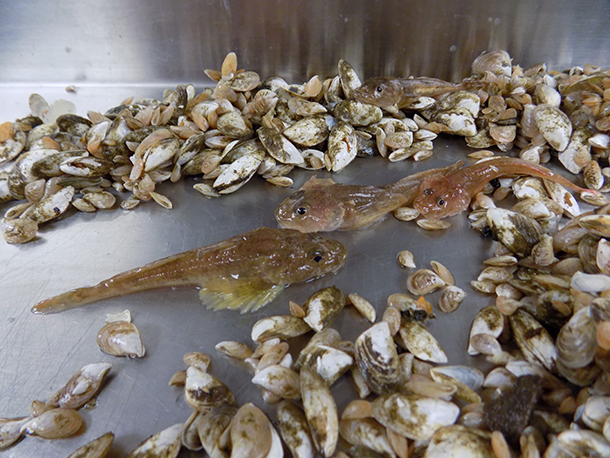
Quagga mussels and Deepwater Sculpin, collected by NOAA during a benthic trawl of Lake Michigan. Population numbers of the sculpin and many other fish species in the Great Lakes have dropped as quagga mussels have skyrocketed. (Photo: NOAA)
The five mighty Great Lakes, separated from the ocean for millennia, hold twenty percent of the world’s surface freshwater. Dreams of trade spurred construction of the St Lawrence Seaway, opening the lakes to intercontinental shipping but transforming their ecosystems, thanks to unintended biological hitch-hikers such as Quagga and Zebra mussels. Environmental journalist Dan Egan’s new book, “The Death and Life of the Great Lakes”, details the changes, and he discussed the impact on the Great Lakes with host Steve Curwood.
Transcript
CURWOOD: It’s Living on Earth. I’m Steve Curwood.
On April 24, 1959, this was the Canadian Broadcasting Corporation…
[MUSIC]
RADIO ANNOUNCER: 270 years ago, fur traders and missionaries hacked their way through the forest of New France. They were looking for an easy way into the Great Lakes and a way to bring lake ships around the rapids to the sea. They completed a 2,000 yard ditch. Then one August night, the Iroquois massacred the building party.
[SHIPS HOOTER]
But they had started. Yesterday, the St. Lawrence Seaway was opened.
CURWOOD: The opening of the link from the Great Lakes to the sea along the US-Canadian border was the fulfillment of a dream and a vision for the heartland of the continent that environmental journalist Dan Egan details in his new book, “The Death and Life of the Great Lakes”.
EGAN: The whole idea behind the St. Lawrence Seaway was to essentially carve an American Mediterranean out of the middle of the continent, by basically blasting a shipping channel between the Great Lakes and the Atlantic Ocean. The Great Lakes collectively span 94,000 square miles, which is basically the size of the UK, but in a lot of ways they were as isolated as a pond in the middle of the woods, because there was no way anything from the ocean or from the eastern seaboard could get up into the lakes because of Niagara Falls and from Lake Ontario, the roaring, tumbling St Lawrence River. And on the western side, there was what they call a subcontinental divide, which basically was a ridgeline that separated the Great Lakes waters from those of the Mississippi River basin.
CURWOOD: Really, Dan, one of the things that's fascinating about your book is you say that when the St Lawrence Seaway was built it was already obsolete practically on the day that it opened. Why didn't it become the trade highway that its builders envisioned, do you think?
EGAN: A couple of reasons. One, they built it on the cheap. They built it to match some existing locks that bypass Niagara Falls - It's known as the Welland Canal - and those locks were built in the 1930s, so there was no sense in building along the St. Lawrence River a whole new set of locks that were much larger because the boats would have hit a bottleneck at the Welland Canal, and they weren't about to rebuild the Welland Canal because it was going to double the cost of the project. So, they built it on the cheap and the size of the locks and the channels really reflected the size of the world's fleet in the 1930s, not in the late 1950s or early 1960s.
And there was another reason too, and that's ice. You know, you can't have a world class shipping corridor that shuts down for three months of the year; otherwise, you know, the car plants aren't going to get their clutches or whatever they need. In this world of just-in-time delivery, you need fast, dependable, predicatable, perennial deliveries, and you can't do that with a navigation route that is choked by ice.
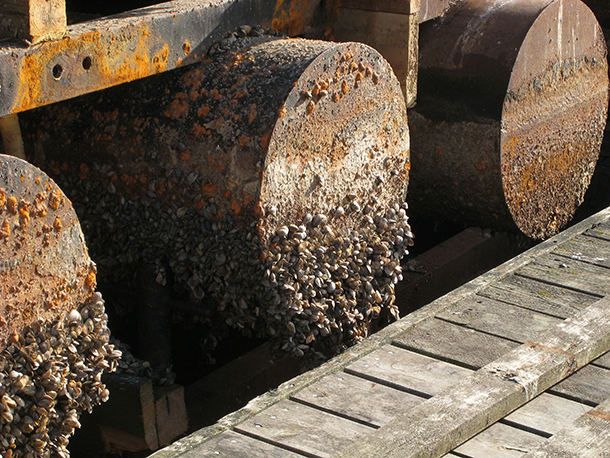
Docks pulled from Port Credit Marina on the Canadian side of Lake Ontario that are covered in zebra mussels. (Photo: Gene Wilburn, Flickr CC BY-NC-ND 2.0)
So, what we're left here is really kind of a boutique shipping industry. The boats, while huge on a human scale, are not are very big on the grand scale of today's modern fleet. Maybe five percent of the world's cargo carrying capacity can fit in the locks. And so what happened was, the seaway opened in 1959, and the container revolution took off almost simultaneously, and that demanded bigger and bigger boats so the seaway got squeezed aside. So, what we have today is a system where a limited number of ships - On average it's been fewer than two per day during the nine month shipping season – come in up the St. Lawrence Seaway from overseas and deliver their cargo to Great Lakes ports. And their cargo is not high-value goods like Nikes and Sonys and Toyotas. It's primarily bulk goods, largely steel, which we know how to build steel here, and outbound is grain. They take grain off the plains and move it to the western Great Lakes ports, put it on boats and take it all over the world.
CURWOOD: But, even if the link the Seaway provided to the rest of the world was not the huge commercial success hoped for, it did bring in plenty of life, though it was the wrong kind. Invasive species from alewives to zebra mussels hitched rides in ballast tanks of ocean freighters. And as the agricultural center of North America flourished, with increasing pesticide and nutrient run-off from corn and wheat fields into the Great Lakes, author Dan Egan says the consequences of the biological pollution became clear.
EGAN: It's really a number of organisms working in concert. I'll give you an idea of how dangerous this biological pollution can be. Zebra and Quagga mussels, tiny little mollusks that invaded the Great Lakes from the Caspian Sea basin, now blanket the bottom of the Great Lakes. If I were to walk from Milwaukee the 80 or 90 miles across the lake to Muskegon, Michigan, I could do the whole trip basically on a bed of Quagga mussels.
So, why is that dangerous? If you look at what happened to Lake Erie in 2014, in late August, I believe, 500,000 people lost their drinking water, and they lost their drinking water because there was an outbreak of a toxic algae called Microcystis which produces a toxin called Microcystin. That's naturally occurring in the Great Lakes, but these mussels basically eat everything but that algae, so that algae has no competition. So, when the conditions set up in western Lake Erie, for example, there's a lot of phosphorus going into the lake because that's big corn country on the western end of Lake Erie. So you get the temperatures and the fertilizer and the water conditions for an algae bloom, and, where 50 years ago it might have been a whole array of different types of organisms, now it's pretty much a Microcystis show. So, it's a pollutant, you know, just as toxic and dangerous and problematic as anything that can come out of an industrial pipe or smokestack.
CURWOOD: So, what's the solution? How do you get rid of these invasive species, these mussels that cause so much trouble?
EGAN: Well, that's the problem, you don't. I mean and that's the difference between this traditional sense of pollution where you can cap a smokestack or plug a pipe, but this doesn't decay or disperse, this biological pollution. It breeds.
It doesn't mean that Lake Erie's water is going to be poisonous from here on out every late summer. There are other things we can do. Specifically, we can reduce the amount of phosphorous going into the lake, but the mussels are here and we're really going to just have to learn to live with them.
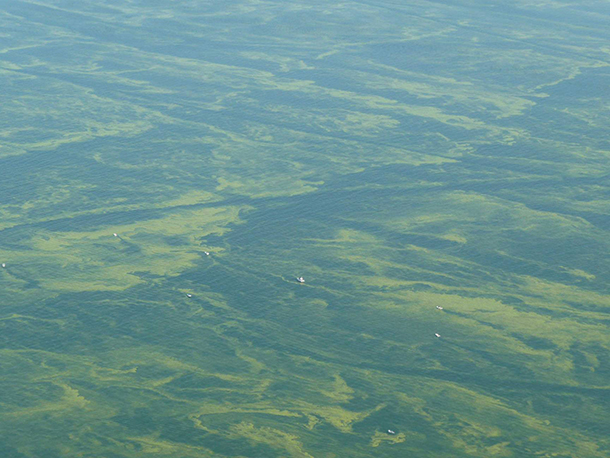
An algae bloom in Lake Erie in 2009. Phosphorus runoff from agriculture along the lake can lead to explosive algae growth in late summer. (Photo: Michiganseagrant, Flickr CC BY 2.0)
CURWOOD: Now there's another significant water passageway that you focus on, and that's the Chicago canal, which was originally built to bridge the divide between the Great Lakes and the Mississippi. Why was this canal constructed, and why is it a problem? Why is the Army Corps of Engineers now looking at ways to block it up?
EGAN: Well, like the St. Lawrence Seaway, the Chicago Sanitary and Ship Canal was a good idea at the time. And so it opened in 1900, and it was built because the booming city of Chicago was basically dumping its raw sewage into the Chicago River. The river flowed into the Lake Michigan, and that's where the city's drinking water intakes were. So, Chicagoans were basically drinking their own filth, and the crude but somewhat elegant solution was to reverse the river, and suddenly we have a river flowing out of Lake Michigan instead of into Lake Michigan.
And it solved Chicago's drinking water problems, but the consequences of doing this are now coming into focus for a number of reasons, not the least of which are these super carp known as Asian carp that have infested the Mississippi River basin. They're kind of like mini baleen whales, but they're not that mini. They can grow up to about 100 pounds and eat up to 20 percent of their weight in plankton today and are moving their way up the Chicago Sanitary and Ship Canal toward Lake Michigan and the Great Lakes.
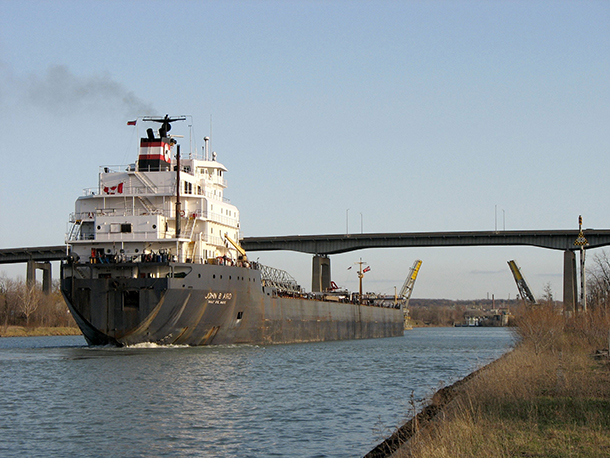
The John B. Aird passes through the Welland Canal, the passage along the St. Lawrence Seaway connecting the Great Lakes to the Atlantic Ocean. (Photo: Wikimedia Commons CC BY 2.0)
CURWOOD: So, overall, invasive species have cost folks around the Great Lakes a lot. We're talking hundreds of millions of dollars, maybe billions of dollars, and as you point out, the Midwest is still doing a lot more trade via railways from east coast harbors than from ships in their own ports. So, I'm scratching my head. Why do these lake economies continue to keep their harbors open to the risk of foreign vessels?
EGAN: Well, that's a good question, and I want to be clear that the seaway and Great Lakes shipping, it is an important navigation corridor, but the vast majority of goods moved along the seaway and on the Great Lakes are moved by local boats, but not by overseas freighters, and these aren't the boats that are bringing in invasive species. The overseas industry is a tiny component of the big picture. It's maybe five percent of the cargo moved by tonnage, and it's the equivalent of roughly two boats a day coming into the seaway during the nine month shipping season. So, it's not a big industry, but it is an important one to the people who own the boats and to the port operators, and they've been very active in making sure that it continues to operate as it has historically.
I should note they've taken steps to address this ballast issue, some big important and effective steps, to require boats coming into the Lakes to flush their ballast tanks mid-ocean with salt water, the idea being that it will expel or kill any freshwater hitchhikers, but the science shows that this salt water flush, though it goes a long way to reducing the threaten, it by no means eliminates it.
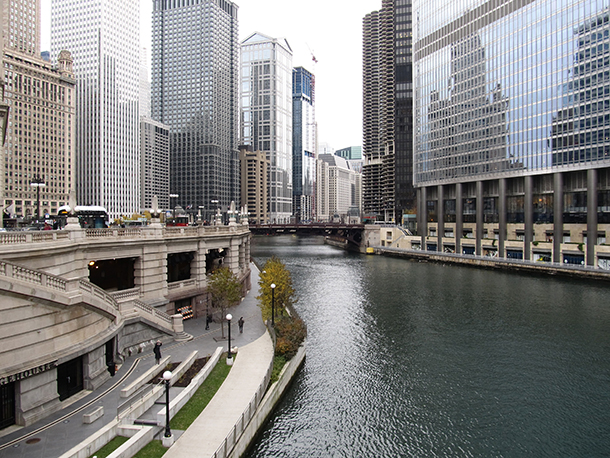
Before 1900, the Chicago River flowed into Lake Michigan, but with the construction of the Chicago Sanitary and Ship Canal, its course was reversed and sent directly into the Mississippi River Basin. This construction allowed the city to drain its sewage downriver but it left the lake vulnerable to invasive species from the Mississippi. (Photo: Ken Lund, Flickr CC BY-SA 2.0)
CURWOOD: So, if it were up to you, would you close off the St Lawrence Seaway, say, “You're not really moving enough international boats to make it worthwhile?”
EGAN: I'll say this. I think it should be put on the table. I think there should be a cost-benefit analysis done and look at what is he economic benefit we're getting from these relatively few ships coming up the seaway compared to the ecological and economic impacts that these invasive species have had, not just on the Great Lakes but across the continent because it turns out that invasions that start in the Great Lakes often go national, and this is why they are chasing Zebra and Quagga mussels all across the northwest and doing everything they can to keep him out of the Columbia River drainage.
CURWOOD: Well, wait. How do Zebra mussels get west if these systems aren't touching, if they're not physically connected?
EGAN: So, I mean, I like to think of it as there's a front door and a back door. The front door is the St. Lawrence Seaway, and the back door is the Chicago Sanitary and Ship Canal. So, species that make their way into the front door often go out the back door. Zebra mussels, Quagga mussels can just ride currents into the Mississippi River basin, and from there it's off to the races.
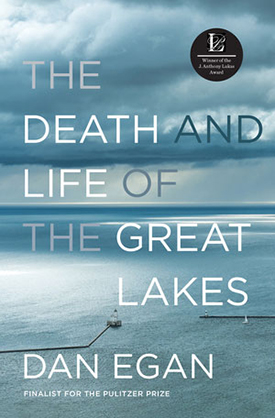
Dan Egan’s book is “The Death and Life of the Great Lakes." (Photo: W.W. Norton & Company, Inc.)
When you think about the number of reservoirs and boat ramps and boats out west and the idea that these people are drawing a line around each water body, doing everything they can to stop a contaminated boat from contaminating the next pond, lake, or reservoir, it's almost an impossible task. Then, if you go across the continent and you look at the boats that have brought in this trouble, every single one of them has to go through this exquisitely tight pinch point. It's called the St Lambert Lock. It's the first lock on the St Lawrence Seaway and it's 80 feet wide. If you stop trouble there, you save a continent's worth of trouble.
CURWOOD: What happens as we go further into this era of human-induced climate disruption, where water is highly variable and we’re going to have a lot of refugees from other parts of America? I'm guessing a lot of these folks are going to head to the Great Lakes, where in a warmer world there's still plenty of water. It’s a lot of folks they need some place to come, and if it's flooded in the coastal areas and if it's dry in the west...
EGAN: Hey, Milwaukee is great. You know, the rust belt could become the blue belt. I think that it's easier for people to move to wet places than for water to move to dry places. The big threat is not people using water along the edge of the lakes. It's people taking water out of the basin because once you take even one drop out of the Great Lakes basin, it doesn't flow back down into the Great Lakes. It flows somewhere else and it’s gone, and enough of those drops, and you get to see the lakes start to shrink.
CURWOOD: Your book is wide-ranging, enjoyably written, and scary in a lot of spots. But as you get towards the end, you do offer up some glimmers of hope.
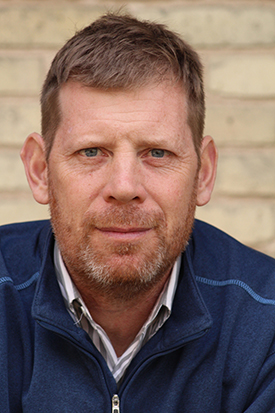
Dan Egan is a reporter for the Milwaukee Journal Sentinel who covers the Great Lakes and the environment. (Photo: The Seminary Co-op)
EGAN: Well, one of the neat things that I think is happening is the lakes are starting to reach some sort of new balance. Zebra and Quagga mussels made it a lake that is not reflective of what it was historically in terms of algae, which is the foundation of the food chain. For years and years that algae just hit a nutritional dead end when it was sucked up by the mussels because nothing could eat the mussels. Well, another wave of invaders came through, and that's the round gobies, and they are little, bug-eyed fish about the size of your thumb, and they are evolutionarily built to eat Zebra and Quagga mussels because they came the same place, the Caspian Sea basin, and they came in the same way, in the ballast tanks of overseas freighters sailing up the seaway. So, the gobies can eat mussels, and mussels are an unlimited energy supply if you can crack those shells and get at them, and the gobies can do that. So, anything that can eat gobis, native species like lake trout, white fish, walleye, are really starting to surge, and they're doing it on the backs of these invasive species.
So the bottom of the food chain looks completely different, but the top is starting to put itself together and looks more like it did 100 years ago than it did anytime in recent history. There's a balance that seems to be emerging, which is encouraging. You say that it's a scary story and it is, and it's a depressing story to a degree, but nature's, you know, obviously resilient, and there are signs that things are getting better for the Great Lakes. I just hope we continue to move in that direction because, you know, healthy fish and clean water and pleasant beaches, that's not a partisan thing, that's just something that everybody likes and should actually demand.
CURWOOD: Dan Egan's book is called "Death and Life of the Great Lakes". Dan, thanks so much for taking the time with us today.
EGAN: Oh, it was my pleasure. Thank you for having me.
Links
Living on Earth wants to hear from you!
Living on Earth
62 Calef Highway, Suite 212
Lee, NH 03861
Telephone: 617-287-4121
E-mail: comments@loe.org
Newsletter [Click here]
Donate to Living on Earth!
Living on Earth is an independent media program and relies entirely on contributions from listeners and institutions supporting public service. Please donate now to preserve an independent environmental voice.
NewsletterLiving on Earth offers a weekly delivery of the show's rundown to your mailbox. Sign up for our newsletter today!
 Sailors For The Sea: Be the change you want to sea.
Sailors For The Sea: Be the change you want to sea.
 The Grantham Foundation for the Protection of the Environment: Committed to protecting and improving the health of the global environment.
The Grantham Foundation for the Protection of the Environment: Committed to protecting and improving the health of the global environment.
 Contribute to Living on Earth and receive, as our gift to you, an archival print of one of Mark Seth Lender's extraordinary wildlife photographs. Follow the link to see Mark's current collection of photographs.
Contribute to Living on Earth and receive, as our gift to you, an archival print of one of Mark Seth Lender's extraordinary wildlife photographs. Follow the link to see Mark's current collection of photographs.
 Buy a signed copy of Mark Seth Lender's book Smeagull the Seagull & support Living on Earth
Buy a signed copy of Mark Seth Lender's book Smeagull the Seagull & support Living on Earth

